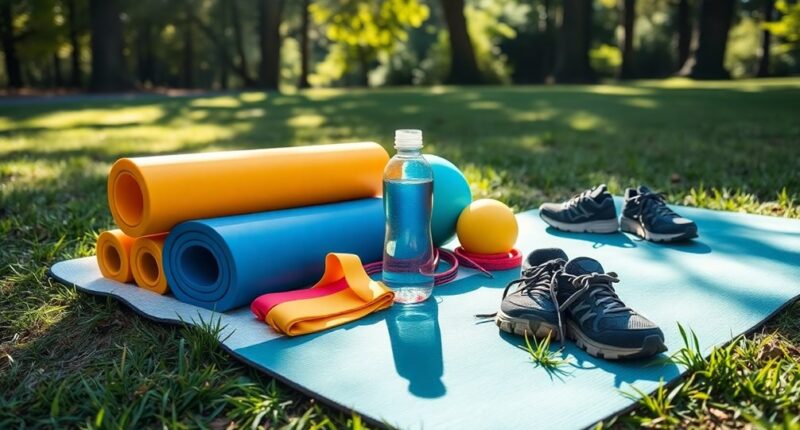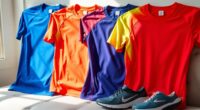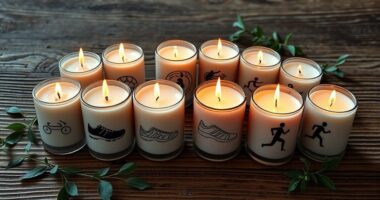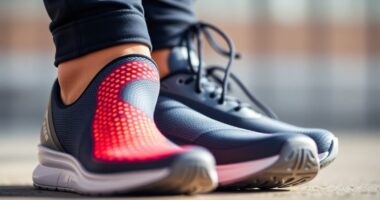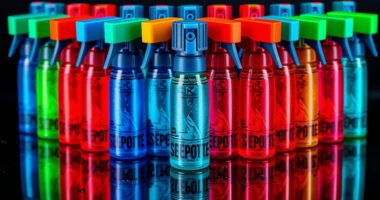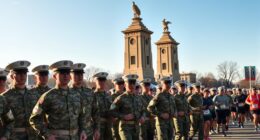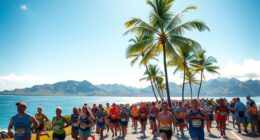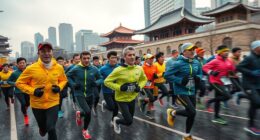As a runner, I can't stress enough how essential recovery tools are in my routine. From muscle roller sticks to massage balls, these gear pieces tackle soreness and boost performance. I swear by the benefits of a solid recovery drink mix and my favorite leg massager for circulation. Each tool serves a unique purpose, helping me bounce back faster after tough runs. Stick around to discover all the must-haves for your post-run recovery regimen!
Key Takeaways
- Incorporate multi-functional tools like the Physix Gear Roller Stick for targeted muscle recovery and to relieve soreness effectively.
- Utilize the Cold Therapy Machine post-run for efficient pain relief and reduced swelling through adjustable temperature and timer settings.
- Consider the Easezen Compression Boots for 360° air compression therapy, enhancing circulation and alleviating post-run muscle fatigue.
- Use the Vibration Plate Exercise Machine to promote lymphatic drainage and deep muscle activity with adjustable speeds and modes.
- Implement the Achilles Strap for lightweight support during recovery, particularly for those with Achilles tendonitis or tightness after running.
Skratch Labs Post Workout Recovery Drink Mix with Chocolate
If you're a runner looking for an effective way to enhance your recovery post-workout, Skratch Labs Post Workout Recovery Drink Mix with Chocolate is a fantastic choice. This mix combines casein and whey protein, along with one billion probiotics per serving, supporting muscle repair and digestive health. With a balanced 4:1 carb to protein ratio, it helps you recover faster. Plus, it tastes delicious—no artificial sweeteners here! I love how easy it is on my stomach, making it a go-to after those long runs. While it might be pricier, the natural ingredients and effectiveness make it worth every penny.
Best For: Runners and athletes seeking a delicious and effective post-workout recovery solution with natural ingredients.
Pros:
- Natural ingredients with no artificial sweeteners, enhancing taste and health benefits.
- Contains probiotics that support digestive health and overall recovery.
- Features a balanced 4:1 carb to protein ratio, promoting faster recovery.
Cons:
- Higher price point compared to some other recovery products on the market.
- Contains calories and sugar, which may be a concern for some users.
- Some flavors may have received mixed reviews, affecting overall satisfaction.
Muscle Roller Stick for Athletes
For dedicated athletes and runners, the Muscle Roller Stick is an essential tool for post-workout recovery. I can't tell you how much it helps relieve tight muscles after a long run. Its sturdy design rolls smoothly, targeting those pesky trigger points in my legs without pinching my skin. I appreciate how it promotes blood circulation and helps reduce stiffness, making me feel more relaxed afterward. Plus, I've noticed my skin looking firmer with regular use. While some might prefer a softer surface, I find this roller invaluable for tackling muscle knots and keeping my body in top shape.
Best For: Athletes and active individuals seeking effective muscle relief after workouts and physical activities.
Pros:
- Effectively targets muscle trigger points, relieving tension and pain.
- Promotes blood circulation and fascia conditioning, reducing stiffness.
- Lightweight and easy to use, making it a convenient recovery tool.
Cons:
- May be less effective on back muscles compared to leg muscles.
- Some users may prefer a softer surface for added comfort.
- Limited versatility for use on certain body areas.
LiftAid Shoulder Pulley for Physical Therapy
The LiftAid Shoulder Pulley is an essential tool for runners recovering from shoulder injuries or surgery, as it effectively enhances strength and range of motion. I've found it particularly beneficial for targeting rotator cuff muscles and stabilizers, vital for my rehabilitation. The durable nylon rope and ergonomic handles make it comfortable to use, even during extended sessions. Plus, its compact design allows me to set it up anywhere, whether at home or on the go. I appreciate that it's affordable compared to physical therapy sessions, and it's been a game-changer in my recovery routine.
Best For: Individuals recovering from shoulder injuries or surgery who need to enhance shoulder strength and range of motion.
Pros:
- Durable construction with high-strength nylon rope ensures long-lasting use without stretching or fraying.
- Ergonomic handles provide a comfortable grip, allowing for extended use during rehabilitation exercises.
- Portable and compact design makes it easy to set up and use at home or on the go.
Cons:
- May require assistance for setup initially, particularly for those with limited mobility.
- Effectiveness can vary based on individual injury severity and adherence to a therapy routine.
- Limited to shoulder exercises, may not offer comprehensive rehabilitation for other areas.
Coolrunner Massage Ball, Manual Roller Massager (2-Pack)
Designed specifically for those who push their bodies to the limit, the Coolrunner Massage Ball and Manual Roller Massager (2-Pack) is an essential recovery tool for runners and athletes alike. This versatile set helps soothe sore muscles in my neck, legs, and back, enhancing blood circulation with controlled pressure. I love that it's made from durable, skin-friendly resin and is safe to use over clothing or with massage oils. The 360-degree spin and silicone grip make it easy to maneuver. Whether I need light relief or deep tissue therapy, this compact duo is perfect for home or travel!
Best For: Athletes, runners, and anyone seeking effective self-massage therapy for sore muscles.
Pros:
- Durable and skin-friendly resin ensures safety and longevity for repeated use.
- Versatile application allows for use over clothing, with massage oils, or on dry skin.
- Compact size makes it travel-friendly and easy to store.
Cons:
- Some users report durability issues if dropped, requiring careful handling.
- May not provide sufficient relief for those needing intense deep tissue therapy.
- Effectiveness can vary based on individual muscle tension levels and personal preferences.
Idson Muscle Roller Stick for Athletes
If you're an athlete looking for a reliable way to relieve muscle soreness and tightness, the Idson Muscle Roller Stick is a game changer. It's lightweight and compact, making it perfect for the gym or travel. With nine independent rollers, it effectively targets sore spots in your calves, hamstrings, and more. I love how it improves circulation and reduces stiffness, helping me recover faster after tough workouts. Plus, it's affordable and durable, recommended by trainers and therapists alike. I've noticed significant relief, and it's easy to store in my gym bag. Give it a try; you won't regret it!
Best For: Athletes and casual users seeking effective muscle relief from soreness and tightness before and after workouts.
Pros:
- Effective muscle massage with nine independent rollers targeting hard-to-reach areas.
- Lightweight and portable, making it easy to carry in gym bags or travel cases.
- Affordable and durable, often available for under $10, with positive recommendations from trainers and therapists.
Cons:
- Some feedback indicates areas for improvement in plastic quality.
- May not be as effective for users with extremely high muscle tension or severe injuries.
- Limited color options might not appeal to all users.
Yansyi Muscle Roller Stick for Athletes
For athletes seeking efficient recovery tools, the Yansyi Muscle Roller Stick stands out with its ability to promote myofascial release and trigger point therapy. I love how it increases blood circulation and helps alleviate soreness and stiffness after intense workouts. Its design features nine independent rollers that target tight knots across various muscle groups, from my legs to my shoulders. Plus, it's compact and super portable, making it easy to use at the gym or while traveling. With its durable construction, it's a cost-effective alternative to pricey massage sessions, and I highly recommend it for anyone serious about their recovery routine.
Best For: Athletes and fitness enthusiasts looking for an effective tool to enhance muscle recovery and relieve soreness.
Pros:
- Promotes myofascial release and reduces muscle soreness and stiffness effectively.
- Compact and portable design allows for easy use at the gym, home, or while traveling.
- Durable construction ensures long-term reliability and cost-effectiveness compared to massage therapy.
Cons:
- May require some initial adjustment to find the right pressure and technique for optimal results.
- Not suitable for individuals with certain medical conditions or injuries without prior consultation with a healthcare professional.
- Limited to self-application, which may not provide the same level of relief as professional massage therapy.
Fittest Pro Wisdom Teeth Ice Pack Head Wrap for Oral Surgery
The Fittest Pro Wisdom Teeth Ice Pack Head Wrap is an essential recovery tool for anyone undergoing oral surgery, especially wisdom teeth extraction. I found it incredibly helpful for pain relief post-surgery. Its durable neoprene design fits comfortably around my face, and the adjustable Velcro strap guarantees a snug fit. I love that it comes with four gel ice packs for both hot and cold therapy—just freeze them for cold relief or microwave for heat. It stays cold for 20-30 minutes, and I can wear it hands-free while going about my day. It's definitely a must-have for recovery!
Best For: Individuals recovering from oral surgeries, such as wisdom teeth extraction or TMJ issues, who need effective pain relief.
Pros:
- Durable neoprene design with adjustable Velcro strap for a comfortable and customizable fit.
- Comes with four gel ice packs for versatile hot and cold therapy options.
- Allows for hands-free use, enabling mobility during recovery.
Cons:
- Some users reported issues with gel leakage after extended use.
- May require frequent freezing or microwaving for continued effectiveness.
- The fit may not be ideal for all head sizes, despite the adjustable strap.
Juvo Toilet Aid – Personal Bottom Wiping Tool
Designed specifically for individuals with limited mobility, the Juvo Toilet Aid offers a practical solution for those recovering from surgery or dealing with age-related challenges. Its 18-inch wand makes self-wiping easier, promoting dignity and independence. I've found it especially useful after surgeries like laminectomy. The easy squeeze trigger securely holds tissue, and it can be used from either direction, though using it from the back can be tricky for some. While users appreciate its functionality, issues like the locking mechanism wearing out and an ineffective caddy have been noted. Overall, it's a handy tool for anyone needing extra assistance.
Best For: Individuals with limited mobility, including seniors, pregnant women, and those recovering from surgery.
Pros:
- Easy to use with a secure locking mechanism for tissue.
- Promotes independence and dignity in personal hygiene.
- Suitable for a variety of users including those with age-related challenges.
Cons:
- The locking mechanism may wear out over time, affecting usability.
- The integrated caddy is considered ineffective for storage.
- Some users report issues with the quality of materials and grip design.
Achilles Strap – Neoprene Ankle Support for Achilles Tendonitis
Runners dealing with Achilles tendonitis will appreciate the Achilles Strap's patented Crosstrap design, which delivers targeted pressure exactly where it's needed most. I found that it provides 20% more isolated pressure at the critical intersection, alleviating discomfort without the bulk of traditional braces. Made from durable neoprene and nylon, it's comfortable and discreet. Many users, including myself, have experienced significant pain relief—some even report up to 95% reduction. At under $20, it's a great trial option for anyone skeptical about expensive alternatives. Just be cautious if you need strong compression, as it might not suffice for severe cases.
Best For: Runners and active individuals seeking a lightweight and effective solution for Achilles tendonitis pain relief.
Pros:
- Provides targeted pressure with patented Crosstrap design, enhancing comfort and reducing pain.
- Made from durable neoprene and nylon, ensuring longevity and a discreet fit during activities.
- Affordable option at under $20, making it accessible for users hesitant to invest in more expensive braces.
Cons:
- May not offer sufficient compression for individuals with severe cases or chronic conditions.
- Some users report discomfort due to excess Velcro, especially for smaller ankles.
- Mixed reviews on durability, with instances of fraying and loss of Velcro grip after limited use.
Vibration Plate Exercise Machine for Whole Body Workout
Looking to enhance your recovery routine? The Vibration Plate Exercise Machine has become a game changer for me. With 240 adjustable speeds and 10 preset modes, it targets deep muscle activity while promoting lymphatic drainage. I love that it fits easily under my desk and operates quietly, making it perfect for multitasking. In just 10-15 minutes, I feel my soreness reduce, and my flexibility improves. Plus, the included resistance bands allow a full-body workout. It's sturdy and effective, making it ideal for both post-run recovery and staying active during busy days. I highly recommend giving it a try!
Best For: Individuals seeking an effective recovery tool and a convenient way to stay active during busy schedules.
Pros:
- 240 adjustable speeds and 10 preset modes allow for a customizable workout experience.
- Compact design makes it easy to store under desks or in closets, perfect for small spaces.
- Includes resistance bands for a full-body workout, enhancing versatility.
Cons:
- May require initial adjustment for users new to vibration training.
- Noise level under 60dB might still be noticeable in quiet environments.
- Weight capacity of 330 lbs may not accommodate all users effectively.
Physix Gear Roller Stick – Muscle Roller Massage Stick for Deep Tissue Massaging
If you're an athlete seeking relief after intense workouts, the Physix Gear Roller Stick is an excellent choice for deep tissue massage. This compact, lightweight tool easily fits in my gym bag, making it perfect for on-the-go recovery. Its ergonomic design allows me to apply consistent pressure, targeting those deep muscle knots that cause discomfort. I love using it before and after my runs, as it helps reduce soreness and enhances my flexibility. Plus, it's durable and comes with a self-massage guide, ensuring I get the most out of my recovery routine. Give it a try—you won't regret it!
Best For: Athletes, including runners and gym-goers, seeking effective relief from muscle tightness and soreness.
Pros:
- Ergonomic design allows for effortless operation and consistent pressure application.
- Compact and portable, making it easy to use at home, in the gym, or while traveling.
- Highly rated for effectiveness in alleviating muscle knots and enhancing recovery routines.
Cons:
- Some users may find it requires practice to achieve the desired pressure on certain muscle groups.
- Limited color options, as it is only available in black.
- May not be suitable for those who prefer larger massage tools for more extensive muscle coverage.
Cold Therapy Machine for Post-Surgery Care and Injuries
For anyone recovering from knee surgery or dealing with injuries like ACL or MCL tears, a Cold Therapy Machine can be a game-changer. I found it invaluable for managing post-operative pain and swelling. With a 9-quart cooling reservoir and a whisper-quiet pump, it's incredibly user-friendly. The conforming cold therapy pad distributes ice water evenly, providing relief without added discomfort. I love that I can adjust the temperature and set the timer for 20, 40, or 60 minutes. It's compact and portable, making it easy to use anywhere. Plus, the 180-day money-back guarantee gives me peace of mind.
Best For: Individuals recovering from knee surgery or experiencing acute joint pain from injuries like ACL and MCL tears.
Pros:
- Provides natural pain relief without the need for medication.
- User-friendly design with adjustable temperature and timer settings.
- Compact and portable, making it easy to use in various locations.
Cons:
- Some users report minor drawbacks with the size and insulation.
- May require regular refill of the cooling reservoir for extended use.
- A few users noted that initial setup could be slightly confusing.
Feelfree Guasha Scraping Massage Tool for Soft Tissue
The Feelfree Guasha Scraping Massage Tool is perfect for runners seeking effective recovery from muscle soreness and injuries. Made from medical-grade stainless steel, its polished surface glides smoothly over the skin, making it easy to clean and durable. I love using it after long runs; it targets soft tissue, helping to break down adhesions and improve recovery time. Just apply a bit of massage oil and glide the tool along your muscles for a soothing experience. It's lightweight and travel-friendly, so I always have it on hand. Plus, at under $10, it's a fantastic value for my self-care routine!
Best For: Runners and athletes seeking effective recovery from muscle soreness and injuries.
Pros:
- Durable and easy to clean due to its medical-grade stainless steel material.
- Lightweight and travel-friendly, making it convenient for on-the-go use.
- Cost-effective at under $10, offering great value compared to similar tools.
Cons:
- May require the use of body emulsion or massage oil for optimal results.
- Effectiveness can vary based on individual technique and experience.
- Limited to soft tissue massage; not suitable for deep tissue or more intense therapy needs.
Vive Shoulder Pulley for Physical Therapy
Designed specifically for those recovering from shoulder injuries or surgeries, the Vive Shoulder Pulley stands out as an essential tool for anyone looking to regain mobility and strength. Its durable metal casing and smooth nylon pulley make exercises easy and effective. I love the padded handles that provide a comfortable grip while the non-slip door strap guarantees secure installation. Whether I'm working on simple pendulum movements or more complex stretches, the adjustable button stoppers let me control my range of motion. With a 60-day guarantee, it's a low-risk investment for improving shoulder health in the comfort of my home.
Best For: Individuals recovering from shoulder injuries or surgeries who seek to improve mobility and strength.
Pros:
- Durable design with a smooth operation, ensuring effective rehabilitation exercises.
- Comfortable padded handles and adjustable button stoppers for a customized experience.
- Highly rated by users and recommended by physical therapists for home use.
Cons:
- Some users reported issues with packaging upon delivery.
- May require some initial setup time for installation over doors.
- Limited to shoulder rehabilitation, not suitable for other body parts.
Leg Massager for Circulation and Pain Relief
If you often experience leg cramps or muscle fatigue after your runs, the Easezen Compression Boots might just be the recovery tool you need. These boots offer a 360° air compression therapy that targets your feet, calves, and thighs, providing customizable relief. With six modes and three pressure intensities, you can easily find the perfect setting for your needs. I love how they improve circulation and alleviate discomfort after a tough workout. Plus, their portability means I can use them anywhere. They make a thoughtful gift for anyone struggling with similar issues, and the one-year warranty adds peace of mind.
Best For: Individuals experiencing leg cramps, muscle fatigue, or circulation issues, especially athletes and those with varicose veins or lymphedema.
Pros:
- Effective relief from leg pain and discomfort.
- Customizable settings with multiple modes and pressure intensities for personalized therapy.
- Portable design with a carrying bag, making it easy to use anywhere.
Cons:
- Some users may find the device slightly bulky for storage.
- Requires a power source, limiting outdoor use without an outlet.
- May take time for new users to find their preferred settings.
Factors to Consider When Choosing Recovery Tools for Post-Run
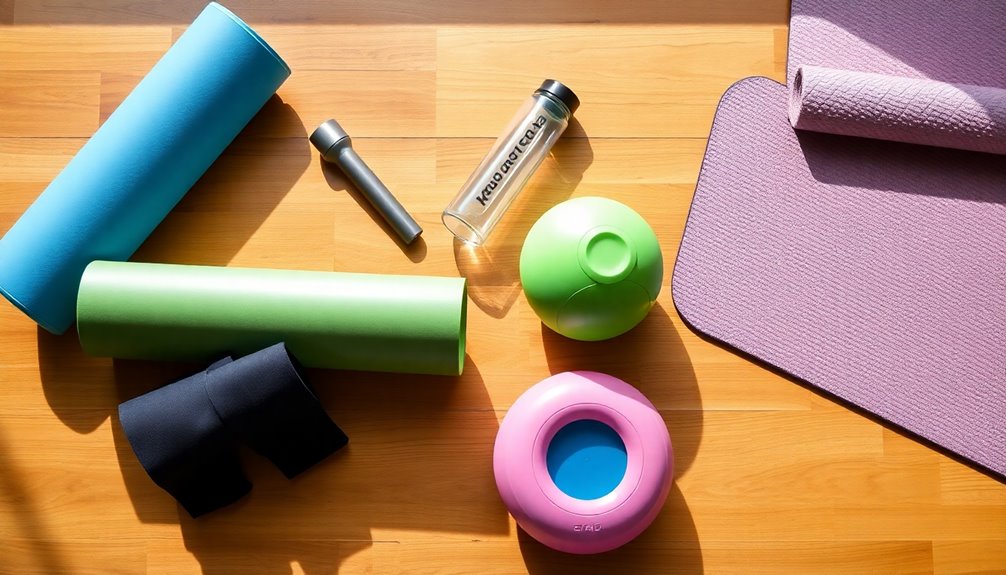
When I look for recovery tools after a run, I think about how well they'll relieve muscle soreness and whether they're easy to use. Portability and material quality also matter, especially if I want something durable for frequent use. It's important that the tool can adapt to different recovery needs, making my post-run routine more effective.
Muscle Soreness Relief
After a challenging run, I often find myself battling muscle soreness, which can really hinder my recovery. To tackle this, I rely on recovery tools that boost blood circulation and reduce stiffness. Foam rollers and massage sticks are my go-to for myofascial release and trigger point therapy, helping me target those pesky muscle knots. I also incorporate compression therapy devices to enhance blood flow and minimize swelling. For immediate relief, ice packs work wonders against inflammation after intense workouts. Finally, I use massage balls and vibration devices to promote active recovery, maintaining muscle elasticity and cutting down soreness. By incorporating these tools, I feel ready for my next run in no time.
Portability and Convenience
Choosing the right recovery tools for post-run is essential, and I always prioritize portability and convenience. I look for lightweight and compact options that make it easy to transport to the gym or my running spot. Tools with portable designs let me use them at home, while traveling, or even at the office for quick muscle relief. I also prefer items that can be easily disassembled or stored, maximizing space in my gym bag. User-friendly features are a must, as I want quick setups after a tiring run. Finally, I evaluate the durability of materials; sturdier options stand up to frequent transport and use, ensuring I get the relief I need without sacrificing effectiveness.
Versatile Application for Recovery
While I'm recovering from a run, I want tools that can tackle various muscle groups and cater to my specific needs. I look for recovery tools that effectively target the calves, quads, hamstrings, and lower back, alleviating soreness and tension. Versatile options, like those offering both deep tissue relief and lighter massage techniques, let me customize my recovery based on how I feel that day. I also appreciate tools that promote blood circulation and lymphatic drainage, as they help reduce muscle fatigue and swelling, speeding up healing. Plus, having recovery tools that I can use at home, in the gym, or while traveling gives me the flexibility to maintain a consistent post-run routine, enhancing my overall recovery experience.
Ease of Use
When I'm selecting recovery tools for post-run relief, I always prioritize ease of use. I look for ergonomic designs and comfortable grips, especially since I sometimes have limited mobility after a tough run. Lightweight and portable tools are a must; I want to easily use them at home, the gym, or even while traveling. Simple operation mechanisms, like trigger systems or adjustable settings, make my recovery routine quick and effective without any hassle. Versatility is key, too—I prefer tools that can target multiple muscle groups and adjust pressure levels effortlessly. Finally, user-friendly features, such as clear control panels or preset modes, enhance my overall experience and guarantee I get the most out of my recovery sessions.
Material Quality and Durability
Selecting recovery tools that boast high material quality and durability is vital for maximizing their effectiveness and lifespan. I always look for products made from durable thermoplastic rubber or polypropylene, as these materials enhance longevity. Reinforced construction, like double-stitching, guarantees they can withstand frequent use without wear. I also prefer tools with non-slip grips and ergonomic designs, which contribute to comfort and safety during my recovery sessions. It's essential to evaluate the ease of cleaning; I opt for skin-friendly, non-porous materials that are hygienic and durable. Finally, I trust tools that come with positive user feedback on their performance over time, confirming they can handle the demands of my intense post-run recovery routine.
Cost-Effectiveness
Cost-effectiveness plays an essential role in choosing recovery tools for post-run use. When I evaluate my options, I look at the balance between the initial cost and the long-term benefits. High-quality tools might seem pricey at first, but their durability often means fewer replacements down the line. I also consider how often I'll use a tool and whether it can serve multiple functions. This not only saves money but also space in my gear bag. Additionally, I keep in mind the potential savings from fewer injuries and faster recovery times, which translate to less downtime and more consistent training. Finally, low-maintenance tools tend to be more cost-effective, making my choices even clearer.
Targeted Muscle Groups
Choosing the right recovery tools can make a significant difference in how quickly I bounce back after a run. I always consider which muscle groups, like my calves, hamstrings, quads, and glutes, need targeted relief. These areas endure a lot of strain, so focusing on them is essential. Tools designed for specific muscle groups enhance recovery by promoting myofascial release and reducing tension. I find foam rollers, massage sticks, or massage balls particularly effective for addressing tightness. Understanding where I typically develop knots or soreness helps me select the right tools. For instance, a deeper tissue massage tool is perfect for my tight hamstrings, while a lighter option works well for my calves. Tailoring my recovery makes all the difference.
Enhanced Blood Circulation
When I think about how to enhance my recovery after a run, improving blood circulation is always at the forefront of my mind. Enhanced circulation delivers oxygen and nutrients to my muscles, promoting faster recovery and reducing soreness. I've found that techniques like massage therapy and compression tools effectively clear metabolic waste, like lactic acid, built up during my workouts. Regularly using these recovery tools decreases muscle stiffness and improves flexibility. Plus, boosting blood flow stimulates my lymphatic system, helping remove toxins and supporting my immune function. I've noticed that targeted therapies not only enhance circulation but also improve muscle elasticity, reducing my risk of injury and ultimately elevating my athletic performance.
Frequently Asked Questions
How Often Should I Use Recovery Tools After Running?
I usually use recovery tools after every run, especially if I've pushed myself hard. It helps my muscles recover faster and reduces soreness. I find that using them consistently—like foam rolling or stretching—makes a big difference in how I feel the next day. If I've done a particularly long or intense run, I might even double up on the recovery tools later that day to really aid my recovery.
Are There Any Specific Recovery Tools for Injury Prevention?
Envision this: after a long run, I'm surrounded by foam rollers, resistance bands, and massage balls, all ready to help me stay injury-free. I swear by these tools! Foam rollers ease tight muscles, while resistance bands strengthen and stabilize. I also love using massage balls to target those pesky knots. Incorporating these tools into my routine not only prevents injuries but also keeps me feeling fresh and ready for the next run.
Can I Use Recovery Tools for Cross-Training Activities?
Absolutely, I use recovery tools for my cross-training activities all the time! Tools like foam rollers and massage balls help me relieve tightness and improve flexibility, regardless of the workout. I've found that proper recovery boosts my performance, whether I'm cycling, swimming, or hitting the gym. Incorporating these tools into my routine definitely keeps me feeling strong and ready for whatever challenge comes next. It's all about taking care of my body!
What Are the Signs I Need Recovery Tools?
When my muscles feel like lead weights and my energy's drained, I know it's time to reach for recovery tools. If I'm waking up sore, struggling to climb stairs, or feeling tight after workouts, those are clear signs I need help. I've learned to listen to my body; it speaks volumes. Just like a garden needs care to flourish, my body requires recovery to thrive after training hard.
How Do I Choose the Right Recovery Tool for My Needs?
Choosing the right recovery tool can feel overwhelming, but I've found it helps to start by evaluating my specific needs. I consider my activity level, any areas of soreness, and how much time I can dedicate to recovery. I also think about my budget and look for tools that fit my lifestyle. Experimenting with different options has been key; it's all about finding what works best for me and my body.
Conclusion
Incorporating these recovery tools into your post-run routine is like giving your body a well-deserved hug after the miles you've conquered. Each item serves a unique purpose, helping you bounce back stronger and more energized. Remember, taking care of yourself is just as important as the run itself. So, embrace these tools, listen to your body, and let your hard work shine through in every stride you take! Happy running and recovery!
